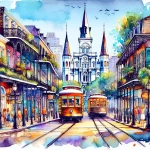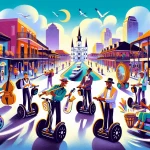New Orleans, a city celebrated for its distinct cultural blend and spirited ambiance, invites travelers worldwide to experience its unique fusion of French, African, and American influences.
In This Article
TL;DR
- Landmarks like the French Quarter, Garden District, and Jackson Square offer a glimpse into the city’s storied past and architectural marvels.
- New Orleans is a melting pot of diverse cultures, exhibited through jazz music, Creole cuisine, and festivities like Mardi Gras.
- Tips include the best times to visit, accommodation options, and navigating the city’s neighborhoods and attractions.
Plan Your Visit to New Orleans
When planning your visit to New Orleans, consider the mild temperatures of spring (March to May) and fall (October to November) as ideal seasons for exploring the city. However, if you want to experience the legendary Mardi Gras celebration, plan your trip for the weeks leading up to Ash Wednesday, typically in February or early March.
Accommodation options in New Orleans range from luxurious hotels to charming bed and breakfasts. For a truly immersive experience, consider staying in the heart of the French Quarter, where you’ll be steps away from iconic attractions, live music venues, and world-renowned restaurants.
Navigating the City
New Orleans offers a variety of transportation options to help you explore its vibrant neighborhoods. The historic streetcars, with fares starting at just $1.25 per ride, provide a scenic and affordable way to traverse the city. The St. Charles Avenue line, the oldest continuously operating streetcar in the world, takes you through the picturesque Garden District.
Walking and biking are also excellent ways to discover the city’s more scenic areas, such as the French Quarter and Esplanade Avenue. Be sure to take breaks in the shade and stay hydrated, especially during the warmer months.
The French Quarter: A Must-See Historic Treasure
The French Quarter, the oldest neighborhood in New Orleans, is a must-visit for its historical significance and cultural richness. Dating back to 1718, this iconic area was founded by French colonists and later influenced by Spanish rule, creating a unique architectural blend.
Key attractions in the French Quarter include Bourbon Street, known for its lively nightlife, music clubs, and restaurants; Jackson Square, a historic park surrounded by beautiful buildings, including the St. Louis Cathedral; and the French Market, a vibrant open-air market featuring local food, crafts, and music.
To experience the French Quarter like a local, venture beyond Bourbon Street and explore the less-crowded side streets. Uncover hidden gems like Preservation Hall, a legendary jazz venue, and Café du Monde, famous for its beignets and café au lait.
Garden District: Architectural Splendor and Serenity
The Garden District, known for its lush greenery and opulent antebellum mansions, offers a serene escape from the bustling French Quarter. Stroll along the tree-lined streets, such as St. Charles Avenue and Prytania Street, to admire the stunning Greek Revival and Italianate architecture.
Must-visit spots in the Garden District include Lafayette Cemetery No. 1, a historic cemetery with elaborate tombs and intricate ironwork; Commander’s Palace, an iconic restaurant serving refined Creole cuisine in a grand Victorian mansion; and Magazine Street, a six-mile stretch featuring unique boutiques, art galleries, and local eateries.
For a deeper understanding of the Garden District’s history and architecture, consider joining a guided walking tour or taking a self-guided tour using a smartphone app.
New Orleans’ Music Scene: The Birthplace of Jazz
New Orleans is synonymous with jazz music, a genre that originated in the city’s African American communities in the late 19th and early 20th centuries. The city’s music scene continues to thrive, with countless venues showcasing live jazz performances every night.
Iconic music venues include Preservation Hall, a historic jazz venue featuring intimate, acoustic performances by local musicians; The Spotted Cat Music Club, a cozy club on Frenchmen Street known for its lively jazz and swing performances; and Snug Harbor Jazz Bistro, a Frenchmen Street institution offering nightly jazz shows and a delicious Creole-inspired menu.
To fully immerse yourself in New Orleans’ music scene, plan your visit around one of the city’s renowned music festivals, such as the New Orleans Jazz & Heritage Festival, held annually in late April and early May.
Culinary Tour: Taste the Flavors of New Orleans
New Orleans’ culinary scene is a delightful fusion of Creole and Cajun cuisines, each with its own distinct flavors and histories. Must-try local dishes include gumbo, a hearty stew featuring a dark roux, vegetables, and meat or seafood, served over rice; jambalaya, a rice dish cooked with vegetables, meat, and seafood, similar to Spanish paella; and beignets, square-shaped fried dough pastries dusted with powdered sugar, famously served at Café du Monde in the French Quarter.
To explore New Orleans’ culinary scene further, consider joining a food tour or cooking class. The New Orleans School of Cooking offers daily demonstrations and hands-on classes, teaching participants how to prepare classic Creole and Cajun dishes.
Celebrating Mardi Gras: The Heart of New Orleans Culture
Mardi Gras, the annual Carnival celebration that takes place in the weeks leading up to Ash Wednesday, is an integral part of New Orleans’ cultural identity. To experience Mardi Gras like a local, attend the parades to catch beads and trinkets from the colorful floats, join a Mardi Gras krewe (the organizations responsible for planning and hosting the parades and balls), and dress up in costume.
To ensure a safe and enjoyable Mardi Gras experience, be aware of your surroundings, stick with your group, and avoid carrying valuables. Arrive early to secure a good spot along the parade route, and respect private property and local laws.
Safety and Etiquette in New Orleans
While New Orleans is generally a safe city for tourists, it’s essential to take common-sense precautions to ensure a trouble-free visit. Be aware of your surroundings, especially in crowded areas like Bourbon Street and during major events like Mardi Gras. Stick to well-lit, populated areas at night, and avoid walking alone in unfamiliar neighborhoods.
When interacting with locals, be respectful of the city’s customs and traditions. Engage in friendly conversation, but avoid intrusive questions or behavior. If you’re unsure about something, don’t hesitate to ask a local for guidance – New Orleanians are known for their hospitality and willingness to help visitors.
By immersing yourself in New Orleans’ iconic landmarks, rich cultural heritage, and vibrant atmosphere, you’ll create unforgettable memories in this one-of-a-kind city. Whether you’re exploring the historic French Quarter, savoring the flavors of Creole cuisine, or dancing to the rhythm of live jazz, New Orleans will captivate your heart and leave you longing to return.






